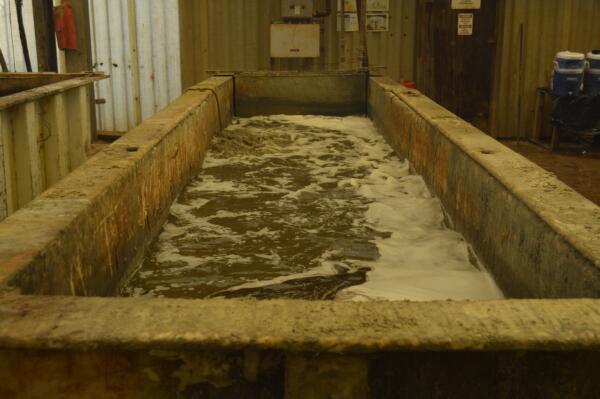SSPC-SP 8 Chemical Cleaning Standard
Is SSPC-SP 8 specified for chemical cleaning before galvanizing?

SSPC-SP 8 is a surface preparation standard intended for acid cleaning to be performed immediately prior to painting. As such, the standard includes elevated surface requirements that make sense if acidic cleaning is used as the primary method for cleaning and etching the steel surface prior to a coating application. In the batch galvanizing process however, acidic cleaning is only one part of the cleaning process and surface etching is not needed for successful galvanizing. The chemical cleaning stage is followed by an acidic flux treatment, often conducted by immersion into a heated zinc-ammonium chloride solution. This galvanizing flux continues to remove surface oxides on the steel and then prevents further oxidation before galvanizing. Therefore, it is unnecessary for the chemical cleaning process at a galvanizing plant to be held to the requirements of SSPC-SP 8.
In the event a galvanizer is required to meet the SSPC-SP 8 standard, all parties should be aware of the following requirements which may be impractical and/or irrelevant to the purpose of achieving suitable galvanizing quality:
- Chemical cleaning in hot or cold solutions of sulfuric, hydrochloric (muriatic), or phosphoric acid require the use of an inhibitor to minimize attack on the base metal, followed by a heated rinse above 140˚F (60˚C).
- Chemical cleaning solutions cannot exceed a dissolved iron content of 6% in sulfuric acid baths, or 10% in hydrochloric acid baths.
- Rinse water must be continuously comprised of only clean water or steam condensate and the total amount of acid or dissolved salts carried over into the rinse tanks must not exceed two grams per liter (0.2% by weight).
- The galvanizer and customer must agree on a visual and/or etching standard to evaluate the acceptability of cleaning.
Instead, batch hot-dip galvanizing including pre-treatment should be specified altogether using the applicable general galvanizing specification for the product to be galvanized:
- ASTM A123 Specification for Zinc (Hot-Dip Galvanized) Coatings on Iron and Steel Products
- ASTM A153 Specification for Zinc Coating (Hot-Dip) on Iron and Hardware
- ASTM A767 Specification for Zinc-Coated (Galvanized) Steel Bars for Concrete Reinforcement
These standards are written as performance-based standards, meaning the galvanizer is required to ensure a defined quality instead of a defined procedure. As the means-and-methods of cleaning the steel prior to galvanizing are left up to the galvanizer, a specific degreasing, chemical cleaning or fluxing standard is unnecessary. In fact, a galvanizer would be unable to meet the performance-based standard requirements if the steel is inadequately cleaned.
For more information on specifying hot-dip galvanized steel, please refer to the AGA publication: Hot-Dip Galvanizing for Corrosion Protection: A Specifier's Guide.
© 2025 American Galvanizers Association. The material provided herein has been developed to provide accurate and authoritative information about after-fabrication hot-dip galvanized steel. This material provides general information only and is not intended as a substitute for competent professional examination and verification as to suitability and applicability. The information provided herein is not intended as a representation or warranty on the part of the AGA. Anyone making use of this information assumes all liability arising from such use.

